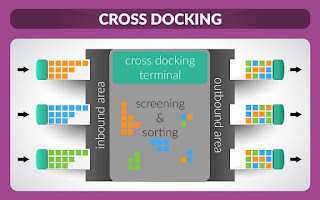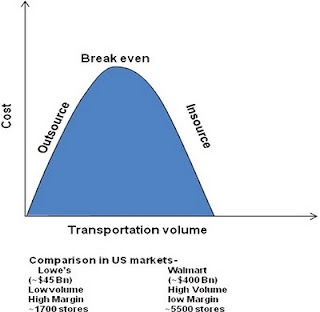FACTORs AFFECTING CROSSDOCKING
Even if Cross-Docking was used popularly in the trucking industry in 20s and later in military operations, Wal-Mart started using it in 80s and made it popular in retailing. Cross-dock is essentially a
process in a warehouse/ facility. In this process, movement of products/ goods
from receiving door to shipping door happens without/ minimal handling of
materials and with no storage. Among many of the other reasons - saving cost in
storage and delivery, faster time to market, reduced space requirement, time
effectiveness in fulfilling JIT manufacturing, and improved economies of scale
for retailers and transportation, are the main reasons because of which organizations
are inclined to extend their supply chain capabilities to adopt this process.
However, retail organizations may
have to consider many of the other aspects before adopting cross docking. Let
us consider few of the important factors which may individually or in
combination with other factors influence the decision of cross docking.
•
Nature of
business (Retail/ wholesale/ CPG etc.)
Direct to store
OR Direct Store Delivery - If Retail organizations selling products to
institutional customers (wholesalers) and if they have the orders already
placed then it also make sense for the retail organizations to place the orders
and deliver the orders directly at the customer’s store/ warehouse locations
(DSD/ DTS). This will avoid manual handling of goods/ materials at the
retailer’s warehouse location. Similar approach can also be taken for confirm
orders from own stores.
Replenishment - If retail organization have their own
stores then they may want to place bulk orders with the vendors and get it
fulfilled/ replenished from their own warehouse. E-Market place like Amazon
receives bulk orders from the vendors in the warehouse and distributing as
single units to the end customers. This type of internet order fulfilment is
another example of delivery from the warehouse location.
CPG organizations selling
products via retailers may opt to have a wide network of distribution. Sellable
inventory will be moved from production facilities by C&F agents to
distributor’s locations and from there to the respective retailers to reach
finally at the end consumers. In other words the retailing of CPG products happen
through multiple staging to cover the larger area or achieve better market
coverage.
•
Nature of
demand (High or low variance)
Looking at the
sales history, Products with high demand variance are less predictable and hence might see difference between forecast figures vs actual sales. Many of
the new products launched or during festival seasons where the demand variance
is considerably high, retailers may order the products to the vendors as per
the market response. This also helps the retailers to reduce the risk in
carrying excess inventory. These products might become good candidates for
cross docking at the retailer’s warehouses.
Products which
have reached their maturity phase in the life cycle, might have stable demand
or might have considerably low variance. Understanding this fact, retailers
might negotiate with the vendors for higher profit margin against the bulk
orders and get those delivered at the warehouse. Store/ customer side demand
can be fulfilled from the warehouse through their regular replenishment and
hence cross docking may not be required.
•
% Margin
[1-(cost/price)]
Storing the
products in the warehouse will increase cost of distribution. Inventory
carrying cost, labor cost, pick and packing cost are the main cost components.
Selling products at the retail outlets with high profile margins, bulk
discounts from the vendors may help the retailers to bear this cost and fulfill
the customer/ store orders via replenishment instead of cross docking. Most of
these products are in their maturity phase of life cycle and hence have a
steady demand throughout the year with some spikes here and there which can be
easily be accommodated through replenishment.
Products with
less profit margin may induce retailers to look for the opportunity for cross
docking as storing these products will fetch more cost hitting harder at the
bottom line.
New product
development may have heavy promotions which might experience high demand
variance for first couple of months. Keeping additional inventory may drive
some risk. A product in its maturity stage might fetch better margins and also
a stable demand from the markets. Non-availability of such products might lose
the customers. All this will be counted for the decision on cross docking or
direct to store delivery.
•
Need of
value added service (VAS) – Assembly, Grouping, Packaging etc
Some of the
products delivered at the warehouse may need some additional services at the
warehouse location. These could be printing labels, quality check, break
packing the products in smaller cases or different packing as per the customer
requirements. Some of the products like light stand, its fabric or home
furniture might need some assembly at the warehouse. Multiple ordering articles
might be repacked in warehouse as one saleable article (kidswear).
These types of
assembly, grouping, Re-packing might increase the time duration for orders to
be cross docked and hence qualify under Flow through. Flow through of these
orders from receiving door to the shipping door might happen through different
lanes (slow/ fast) depending upon time to add one/ more values.
Practically,
cross docking order might reside in the warehouse for less than 24 hours but
flow through orders might stay in the warehouse between 1-7 days.
•
Nature of
product/ item (Perishable/ fragile)
Some of the
grocery products which are perishable in nature like vegetables/ fruits. Some
of perishable products like milk/ ice cream/ raw meat require cold storage.
Such products might have shorter shelf life and hence there is special need to
deliver on time to the retail outlets. Hence such products may not be even
cross docked but might be asked to deliver directly to the retail stores
instead of any intermediate storage/ cross docking facility. These products
might not even be opted for cross docking at all. Vendors might be asked to
send the products directly to the respective demand locations (stores) and
fulfil the delivery (mostly referred as DSD – Direct Store Delivery or DTS –
Direct to Store).
•
Quality
of the item
Products with high
quality standards might not need any type of quality inspection at retailer
warehouse so these products/ items will be moved from receiving locations to
the shipping docks without any quality inspections and hence may qualify for
cross docking. This will help retailers to experience a better customer
response and appreciation for reducing the waiting period and availability.
•
Prepackaged
customer orders
Customer/ store
orders might have multiple SKUs grouped (especially in fashion) with different
colors/ variants (E.g. Pack of more than one T-shirts with different colors). Customers/
stores might want those to be sold that way and hence they might want to order
the same way. Suppliers will be asked to supply the order in pre-packaged form.
These pre-packaged customer orders might be delivered in warehouse of the
retailers and will be cross docked after printing the price labels.
• Customer
behavior (low expectation of presence of product in store, Opting no
alternative/ substitute)
This is mostly
seen in the consumer durable industry. Retailers may not be able to keep all
the models of the same/ different brands in one store due to limited space.
Customers are well aware about this fact and hence even they do not expect to
have all the products inside the store. They are also ready to wait for the
products/ models to be available/ delivered. Many of the customers already know
what they would like to buy and hence may not opt for any other substitute/ alternatives.
By looking at the catalogue, grabbing more information about the variants
available in the store, they may opt for ordering what they want over the
counter and get it delivered at their door step. Such type of buying behavior
may force the retailers to procure and deliver at the customer door step not
even at the store location.





